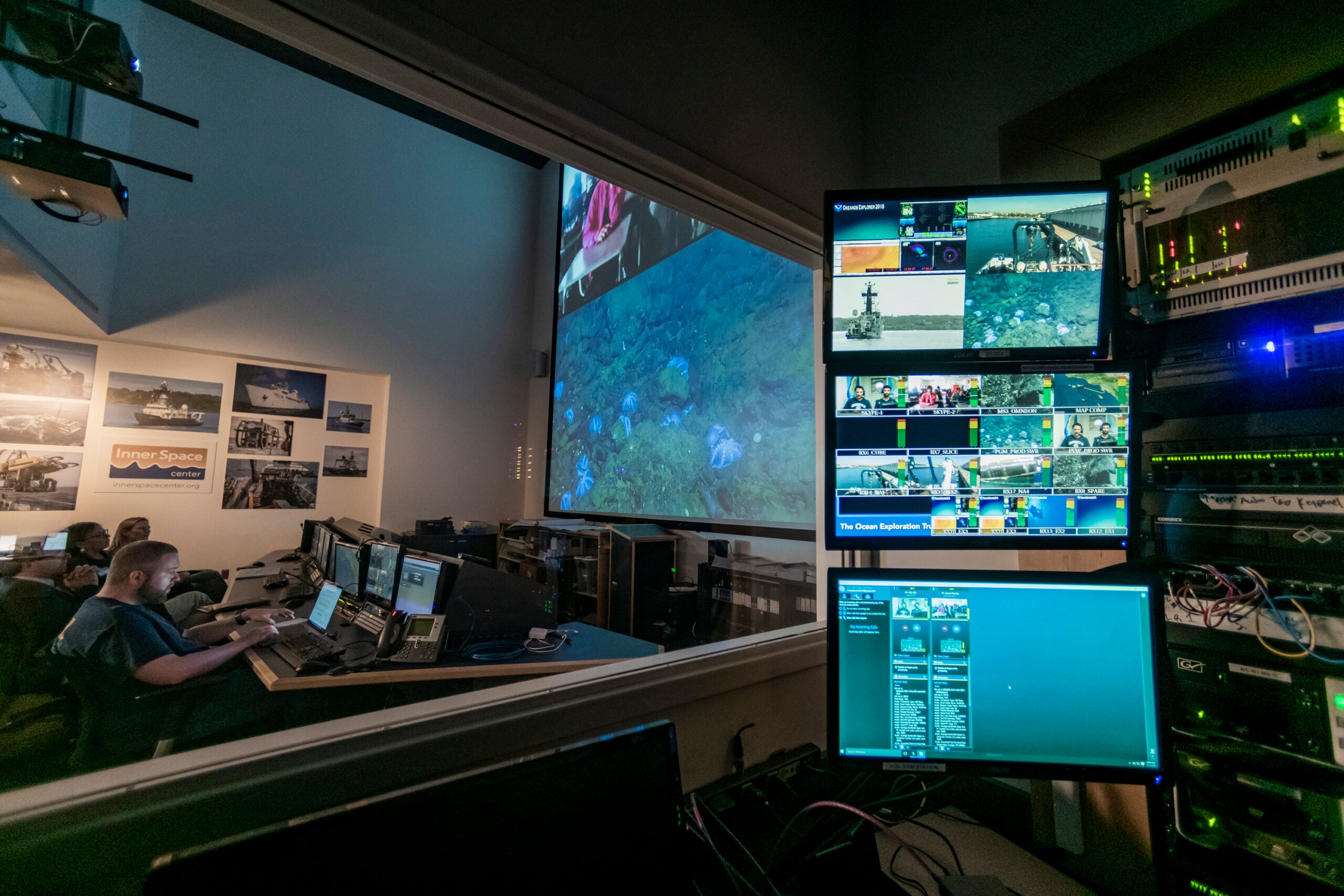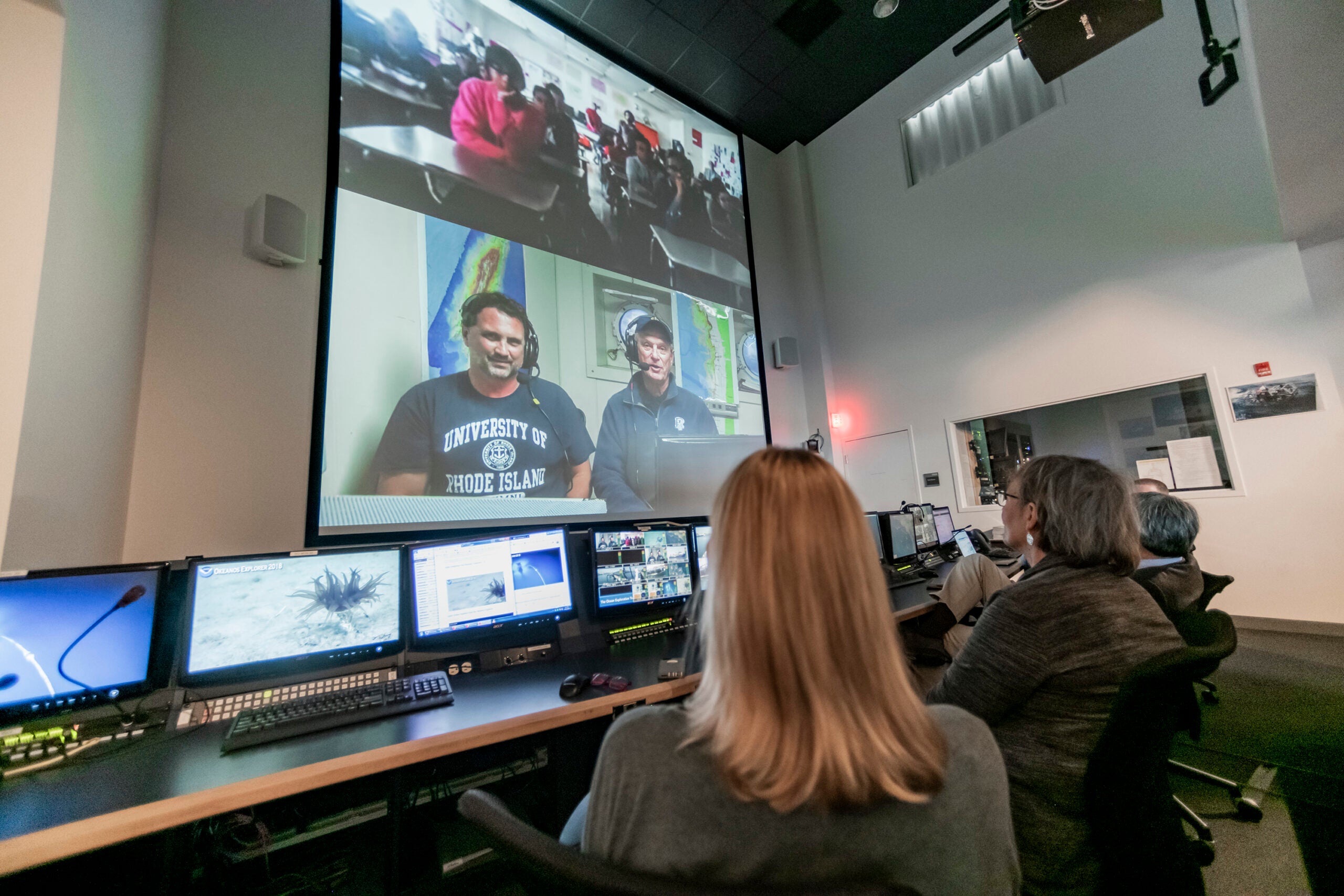NARRAGANSETT, R.I., Nov. 2, 2018 — Students in an engineering class at Central Falls High School can boast to friends that they were able to interact with scientists who were the first to observe last week’s rare discovery of thousands of octopuses tending their eggs 3,000 meters below the ocean surface in waters off California.
That unexpected scientific discovery and the technologies used were shared Nov. 1 when the Inner Space Center at the University of Rhode Island’s Graduate School of Oceanography connected the students in real time to renowned ocean explorer and URI Oceanography Professor Robert Ballard’s expedition aboard the EV Nautilus.
The event demonstrated the important links among ocean research, higher education in ocean science and K-12 teacher education, which Question 2, the higher education bond on the Nov. 6 ballot, seeks to enhance. The measure would provide $45 million to URI and $25 million to Rhode Island College for infrastructure and program enhancements that advance ocean science and teacher education.

In addition to seeing the unprecedented number of brooding octopuses discovered along the seafloor of the Monterey Bay National Marine Sanctuary, the students learned that venturing with remotely operated vehicles to ocean depths of 3,000 meters or more requires researchers to have the most advanced technical and scientific expertise, as well as an unbridled sense of adventure and unflappable demeanor when events go awry — not to mention highly sophisticated and costly exploration vessels and equipment.
Because of those factors, “only a very small club can work at 20,000 feet” deep, Ballard told the students from aboard the EV Nautilus, the flagship exploration vessel of his Ocean Exploration Trust. But for an hour at the end of their school day, the students were members of that club, and they made the most of it, asking questions about the challenges of using equipment in the deep — such as extreme pressure, corrosion and damaging currents — and what type of education prepares you to be an ocean explorer.
Ballard, a URI alumnus known around the world for his discovery of the wreck of the Titanic, advised the students to “study everything,” noting that he majored in chemistry and geology and minored in math and physics before earning a Ph.D. in oceanography at URI.
“I really have a Swiss army knife in my head,” he said. “Get a really broad education and you will always be able to reinvent yourself, as I have done.”
Dwight Coleman, director of the Inner Space Center and expedition leader aboard the ship, told the students he started out in mechanical engineering, took an oceanography course for fun and then switched his major, eventually earning advanced degrees at URI. “Once I started going to sea, I was hooked,” he said.
Mike Filimon, expedition pilot of the remotely operated vehicle (ROV) Hercules and a URI ocean engineering alumnus, came to his vocation much earlier. He recalled visiting Disney World as a first- or second-grader and not wanting to leave the park’s Living Seas exhibit to go on a single ride. “When I saw the opportunity of ocean engineering as a major and underwater archaeology as a minor, I knew I wanted to come to URI,” he said.
The Inner Space Center, the only such facility in the nation, uses satellite technology to link remote locations with real-time video, audio and data connections, and provides live-streaming footage from expeditions to anyone in the world with an Internet connection. At the center, a two-story project screen displayed split images of the Central Falls classroom and the team aboard the EV Nautilus.
Ballard said this is an exciting time for URI and ocean research, with a $125 million National Science Foundation research vessel awarded to a GSO-led consortium earlier this year and due to arrive in 2021. “It will really be the future of ocean science at URI. We’re really going to expand our range of exploration quite a bit,” he said, noting that 95 percent of the world’s oceans remains unexplored.
“We have better maps of Mars than of half of our own country. We want to keep making these discoveries and expand and accelerate our ability to explore,” he said. To do so requires ample resources, and Ballard exhorted the students to remind their parents to vote yes on Question 2 on Tuesday.
URI’s Narragansett Bay Campus is home to the URI Graduate School of Oceanography (GSO), one of the world’s premier oceanographic institutions. Founded in 1961, GSO has built a reputation for excellence in deep water oceanographic research, coastal planning and management, sustainable fisheries and monitoring the health of Narragansett Bay. With operations, researchers, faculty and students worldwide, the Bay Campus education and outreach programs train the next generation of scientists and policymakers, while ensuring Rhode Island’s K-12 teachers and students gain an appreciation for the importance of ocean science through a variety of hands-on programs.
On Nov. 6, Rhode Islanders will vote on Question 2, a $70 million higher education general obligation bond that includes $45 million for upgrades to the Narragansett Bay Campus. If approved, proceeds from the bond will be used to improve the GSO’s pier (required to accommodate a newly awarded Regional Class Research Vessel from the National Science Foundation worth about $125 million), construct a 20,000-square-foot Ocean Technology building, a 12,000-square-foot Marine Operations building and fund other necessary improvements to campus facilities. The remaining $25 million will go to Rhode Island College School of Education.

